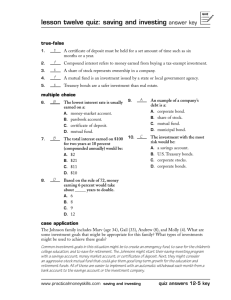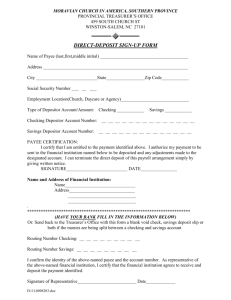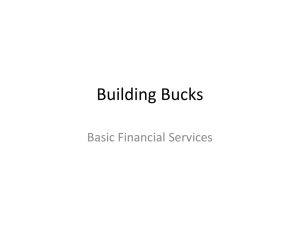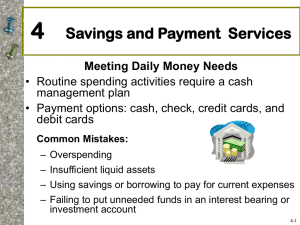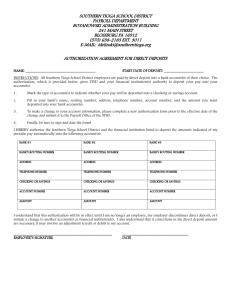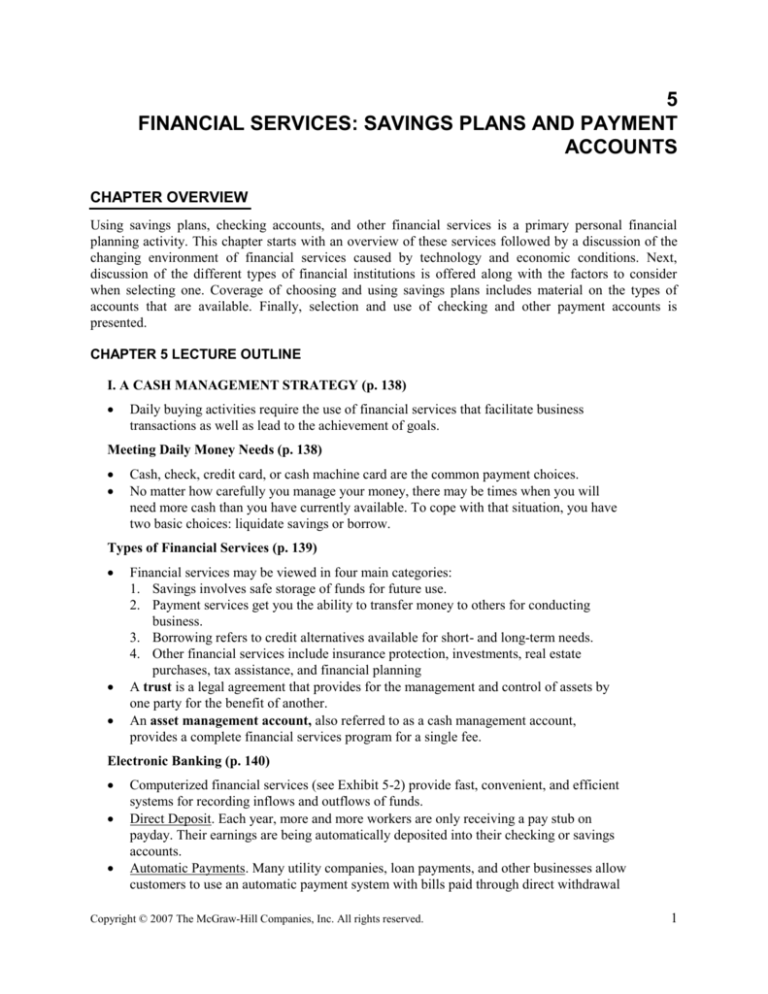
5
FINANCIAL SERVICES: SAVINGS PLANS AND PAYMENT
ACCOUNTS
CHAPTER OVERVIEW
Using savings plans, checking accounts, and other financial services is a primary personal financial
planning activity. This chapter starts with an overview of these services followed by a discussion of the
changing environment of financial services caused by technology and economic conditions. Next,
discussion of the different types of financial institutions is offered along with the factors to consider
when selecting one. Coverage of choosing and using savings plans includes material on the types of
accounts that are available. Finally, selection and use of checking and other payment accounts is
presented.
CHAPTER 5 LECTURE OUTLINE
I. A CASH MANAGEMENT STRATEGY (p. 138)
Daily buying activities require the use of financial services that facilitate business
transactions as well as lead to the achievement of goals.
Meeting Daily Money Needs (p. 138)
Cash, check, credit card, or cash machine card are the common payment choices.
No matter how carefully you manage your money, there may be times when you will
need more cash than you have currently available. To cope with that situation, you have
two basic choices: liquidate savings or borrow.
Types of Financial Services (p. 139)
Financial services may be viewed in four main categories:
1. Savings involves safe storage of funds for future use.
2. Payment services get you the ability to transfer money to others for conducting
business.
3. Borrowing refers to credit alternatives available for short- and long-term needs.
4. Other financial services include insurance protection, investments, real estate
purchases, tax assistance, and financial planning
A trust is a legal agreement that provides for the management and control of assets by
one party for the benefit of another.
An asset management account, also referred to as a cash management account,
provides a complete financial services program for a single fee.
Electronic Banking (p. 140)
Computerized financial services (see Exhibit 5-2) provide fast, convenient, and efficient
systems for recording inflows and outflows of funds.
Direct Deposit. Each year, more and more workers are only receiving a pay stub on
payday. Their earnings are being automatically deposited into their checking or savings
accounts.
Automatic Payments. Many utility companies, loan payments, and other businesses allow
customers to use an automatic payment system with bills paid through direct withdrawal
Copyright © 2007 The McGraw-Hill Companies, Inc. All rights reserved.
1
CHAPTER 5 LECTURE OUTLINE
from a bank account.
An automatic teller machine (ATM), or simply cash machine, is a computer terminal
that allows customers to conduct banking transactions. In addition, some ATMs sell bus
passes, postage stamps, gift certificates, and mutual funds.
A debit card, or cash card, activates ATM transactions and is linked to a bank account.
ATM convenience can be expensive.
A lost or stolen debit card can be expensive. If you notify the financial institution within
two days of losing the card, your liability for authorized use is $50. If you wait any
longer, you can be liable for up to $500 of unauthorized use for up to 60 days. Beyond
that time, your liability is unlimited.
Opportunity Costs of Financial Services (p. 141)
As in all decisions, opportunity cost is what you give up when evaluating, selecting, and
using financial services.
Opportunity costs associated with financial services may include higher return with low
liquidity, higher costs for convenience of 24-hour electronic banking, or lost interest
when a “free” checking account requires that you maintain a minimum balance.
Financial Services and Economic Conditions (p. 141)
2
Changing interest rates, fluctuating consumer prices, and other economic factors
influence the availability and use of financial services.
Copyright © 2007 The McGraw-Hill Companies, Inc. All rights reserved.
CHAPTER 5 LECTURE OUTLINE
II. FINANCIAL INSTITUTIONS (p. 142)
Financial institutions may be viewed in two major categories.
Deposit Institutions (p. 142)
Traditionally, commercial banks have offered the widest range of financial services.
The savings and loan association traditionally specialized in savings accounts and loans
for mortgages
Mutual savings banks, which are owned by depositors, specialize in savings and
mortgage loans.
Credit unions are user-owner, nonprofit, cooperative financial institutions that offer a
wide range of services.
Other Financial Institutions (p. 138)
Many life insurance companies offer policies that contain savings and investment
features.
Investment companies, also referred to as mutual funds, have become involved in
banking-type activities. A common service of these organizations is the money market
fund, a combination savings-investment plan in which the investment company uses
your money to purchase a variety of financial instruments.
Making loans to consumers and small businesses is the main function of finance
companies.
Mortgage companies are organized to provide loans for home purchases.
Pawnshops make loans based on the value of some tangible possession, such as jewelry
or other valuable items. Many low- and moderate-income families use these
organizations to quickly obtain cash loans. Pawnshops charge higher fees than other
financial institutions.
About 17 percent of U.S. households do not have bank accounts, and most financial
institutions won’t cash a check unless you have an account. The over 6,000 checkcashing outlets (CCO) can charge anywhere from 1% to 20% of the face value of a
check; the average cost is between 2% and 3%.
Comparing Financial Institutions (p. 145)
The major factors to consider when selecting a financial institution are:
services offered
convenience/location
safety/deposit insurance
interest rates
fees and charges
Copyright © 2007 The McGraw-Hill Companies, Inc. All rights reserved.
3
CHAPTER 5 LECTURE OUTLINE
III. SAVINGS PLANS (p. 147)
The basis for your attainment of financial goals is the accumulation of funds that results
from an effective savings and investment program.
Regular Savings Plans (p. 147)
Regular savings accounts, traditionally referred to as passbook accounts, involve a low
or no minimum balance and allow savers to withdraw money as needed.
At a credit union, these savings plans are called share accounts.
Certificates of Deposit (p. 148)
A certificate of deposit (CD) is a savings plan that requires you to leave a certain
amount on deposit for a set time period (ranging from 30 days to 5, 10 or more years) in
order to earn a specified interest rate.
Rising rate or bump-up CDs may give savers higher rates at various intervals, such as
every six months. However, beware of ads that highlight a higher rate in the future,
which may only be in effect for the last couple of months of an 18- or 24-month savings
certificate. Also, some bump-ups may require a rather large minimum investment.
Indexed CDs have earnings based on the stock market. In times of strong stock
performance, your CD earnings can be higher than other CDs. However, at other times
you may not earn any interest and may even lose part of your savings. A CD based on
the consumer price index can result in higher returns as inflation increases.
Callable CDs start with higher rates and usually have long-term maturities, as high as 1015 years. These savings plans also have the benefit of federal deposit insurance.
However, the bank may “call” the account after a stipulated period, such as one or two
years, if interest rates drop.
Global CDs combine higher interest with a hedge on future changes in the dollar
compared to other currencies. As exchange rates change, your earnings can fluctuate.
Promotional CDs attempt to attract savers with gifts or special rates. A Boulder,
Colorado, bank offered Rolex watches, archery equipment, and Zodiac inflatable boats in
lieu of interest.
Current information about CD rates at various financial institutions may be obtained at
www.bankrate.com.
Consider creating a CD portfolio with CDs maturing at different times. For example,
$2,000 in a three-month CD, $2,000 in a six-month CD, $2,000 in a one-year CD, and
$2,000 in a two-year CD. This will give you some degree of liquidity and flexibility
when reinvesting your funds.
Money Market Accounts and Funds (p. 149)
A money market account is a savings account that requires a minimum balance and
bases earnings on market interest rates. Money market accounts allow savers to write a
limited number of checks to make large payments or to transfer money to other accounts.
U.S. Savings Bonds (p. 149)
4
Years ago, the low return on savings bonds made their purchase a patriotic act rather
than a wise saving choice. In recent years, however, the Treasury Department has
offered various programs to make buying savings bonds more attractive.
Series EE bonds (called Patriot Bonds after the September 11, 2001, terrorist attacks)
may be purchased for amounts ranging from $25 to $5,000 (face values of $50 to
Copyright © 2007 The McGraw-Hill Companies, Inc. All rights reserved.
CHAPTER 5 LECTURE OUTLINE
$10,000, respectively).
EE bonds increase in value every month as interest accrues monthly and compounds
semiannually. If you redeem EE Bonds before five years, you forfeit the latest three
months of interest; after five years, you are not penalized.
EE bonds purchased between May 1997 and April 30, 2005 earned market-based
interest. Since that time, a fixed interest rate has been paid. Series EE bonds continue
to earn interest for 30 years, well beyond the time at which the face value is reached.
The main tax advantages of Series EE bonds are that (1) the interest earned is exempt
from state and local taxes and (2) you do not have to pay federal income tax on earnings
until the bonds are redeemed.
Redeemed Series EE bonds may be exempt from federal income tax if the funds are used
to pay tuition and fees at a college, university, or qualified technical school for yourself
or a dependent.
Series HH bonds are current-income bonds, which earn interest every six months. The
interest is deposited electronically to your bank account. This interest is taxed as current
income.
The semiannual interest payments of HH bonds make them a popular source of
retirement income. As of 2004, investors are no longer able to reinvest HH bonds or
exchange EE bonds for HH bonds.
The I bond earns a combined rate consisting of: (1) a fixed rate for the life of the bond,
and (2) an inflation rate that changes twice a year. Every six months a new, fixed base
rate is set for new bonds. The additional interest payment is recalculated twice a year,
based on the current annual inflation rate.
I bonds are sold in the same denominations as EE bonds, but are purchased at face value,
not discount. Also, as with EE bonds, the minimum holding period is one year.
Additional information and current value calculations for savings bonds values may be
obtained at www.savingsbonds.gov.
Copyright © 2007 The McGraw-Hill Companies, Inc. All rights reserved.
5
CHAPTER 5 LECTURE OUTLINE
IV. EVALUATING SAVINGS PLANS (p. 150)
Rate of Return (p. 150)
Rate of return, or yield, is the percentage of increase in the value of your savings due to
earned interest.
Compounding refers to interest that is earned on previously earned interest. The more
frequent the compounding, the higher your rate of return will be.
In 1993, Truth in Savings (Federal Reserve Regulation DD) became effective. This law
requires financial institutions to disclose the following information on savings account
plans they offer:
fees on deposit accounts
the interest rate
the annual percentage yield (APY)
other terms and conditions of the savings plan
Truth in savings (TIS) defines annual percentage yield (APY) as the percentage rate
expressing the total amount of interest that would be received on a $100 deposit based on
the annual rate and frequency of compounding for a 365-day period. (See “Financial
Calculations” for additional information on APY.) (p. 152)
Inflation (p. 152)
The rate of return you earn on your savings should be compared with the inflation rate.
In general, as the inflation rate increases, the interest rates offered to savers also
increase. This gives you an opportunity to select a savings option that will minimize the
erosion of your dollars on deposit.
Tax Considerations (p. 152)
Taxes reduce your earnings on savings. For example, a 6.25 percent return for a saver in
a 28 percent tax bracket means a real return of only 4.5 percent. (See “Financial
Planning Calculations” feature on page 146.)
Liquidity (p. 153)
Liquidity allows you to withdraw your money on short notice.
Safety (p. 153)
Most savings plans at banks, savings and loan associations, and credit unions are insured
by agencies affiliated with the federal government.
The Federal Deposit Insurance Corporation (FDIC) provides deposit insurance for banks
and savings and loan associations. The FDIC administers separate insurance funds, the
Bank Insurance Fund and the Savings Association Insurance Fund. Credit unions may
still obtain deposit insurance through the National Credit Union Association (NCUA).
Restrictions and Fees (p. 154)
6
Restrictions and costs may include a delay between the time interest is earned and the
time it is added to your account. Also, some institutions charge a transaction fee for each
deposit or withdrawal.
Copyright © 2007 The McGraw-Hill Companies, Inc. All rights reserved.
CHAPTER 5 LECTURE OUTLINE
V. PAYMENT METHODS (p. 154)
Electronic Payments (p. 154)
Transactions not involving cash, checks, or credit cards have expanded with technology,
improved security, and increased consumer acceptance.
Debit Card Transactions. Most retail stores, restaurants, and other businesses accept
check cards issued by Visa and MasterCard. When the debit card transaction is
processed, the amount of the purchase is deducted from your checking account.
Most debit cards can be used two ways: (1) with your signature, like a credit card, and
(2) with your personal identification number (PIN), like an ATM card.
Online Payments. Banks and Internet companies are serving as third parties to facilitate
online bill payments. Some of these include www.paypal.com, www.checkfree.com, and
www.paytrust.com. When using these services, be sure to consider the monthly charge as
well as online security and customer service availability.
Also on the web are “cyber cash” services designed to serve as financial intermediaries.
These organizations create their own e-money that serves as a medium of exchange for
online transaction; one example is www.cybercash.com.
Stored-Value Cards. Prepaid cards for telephone service, transit fares, highway tolls,
laundry service, and school lunches are very common. While some of these stored-value
cards are disposable, others can be reloaded with an additional amount.
Smart Cards. These “electronic wallets’ are similar to other ATM cards. However, their
imbedded microchip stores prepaid amounts as well as information with account
balances, transaction records, insurance information, and medical history.
Types of Checking Accounts (p. 155)
With a major portion of business transactions conducted by check, a checking account is
a necessity for most people.
The main types of checking accounts are:
regular checking accounts are likely to have a monthly service charge or a minimum
balance to avoid the fee
activity accounts charge for each check written and sometimes for each deposit made
CHAPTER 5 LECTURE OUTLINE
interest-earning checking accounts, also referred to as NOW accounts
Evaluating Checking Accounts (p. 156)
The most common limitation on checking accounts is the amount that must be kept on
deposit to earn interest or avoid a service charge.
Nearly all financial institutions require a minimum balance or service charges for
checking accounts.
The interest rate, frequency of compounding, and interest computation method will affect
the earnings on your checking account.
Financial institutions may offer checking account customers such extra services as 24hour teller machines and home banking services.
Overdraft protection is an automatic loan made to checking customers to cover the
amount of checks written in excess of the available balance.
Copyright © 2007 The McGraw-Hill Companies, Inc. All rights reserved.
7
Managing Your Checking Account (p. 158)
Opening a Checking Account. Start by deciding whether to open an individual account
or joint account.
Making Deposits. Depositing checks may be done with a blank endorsement, a restrictive
endorsement, or a special endorsement. (PPT 5-21)
Writing Checks. The information needed when completing a check includes: (1) the date;
(2) the name of person or organization receiving the check; (3) the amount in figures; (4)
the amount in words; (5) your signature; (6) note the reason for the payment.
Maintaining a Checking Account. A bank statement is a summary of the transactions for
a checking account. A bank reconciliation is prepared to determine the true checking
account balance since a difference between the checkbook and bank statement balance is
likely.
CHAPTER 5 LECTURE OUTLINE
Other Payment Methods (p. 151)
8
A certified check is a personal check with guaranteed payment.
A cashier’s check is the check of a financial institution.
A money order is a payment device purchased from financial institutions, post offices,
or stores.
Traveler’s checks allow you to make payments when away from home.
Copyright © 2007 The McGraw-Hill Companies, Inc. All rights reserved.



